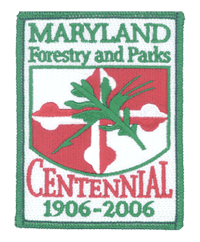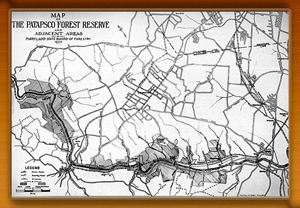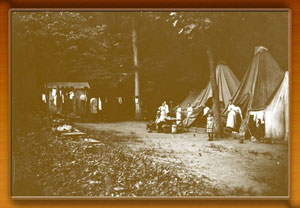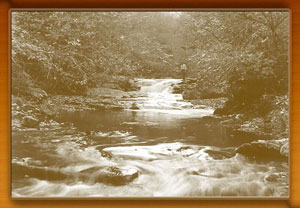 Scientific Forestry And Urban Progressivism:
Scientific Forestry And Urban Progressivism:
The Development of the Maryland Board of Forestry, 1906 to 1921
by Robert F. Bailey
Part 3: Expanding the Forestry Board through Urban Progressivism
Maryland’s scientific forestry efforts and Baltimore’s progressivism came together in the Patapsco Valley. In November of 1910, William M. Ellicott, an architect and member of the Municipal Arts Society, voiced concerns that unless immediate efforts were made, the Patapsco Valley’s trees would fall to the lumberman’s axe. Extolling the Patapsco’s romantic appeal, Ellicott stated that “it offers an alluring opportunity for a ramble in the woods or a walk by the river, and has become a favorite sylvan resort of large numbers of our people.” Unfortunately, “no steps have been taken to purchase it and within a few months a sawmill has been erected and already terrible devastation has been wrought.” However, according to Ellicott, “the owner of the sawmill is thoroughly in sympathy with the desire to save the remainder of the forest and has volunteered to delay the work.”44
 Two years earlier, in January 1908, Besley had also expressed concerns about Baltimore’s surrounding forestland. He told the
Sun, “It might be possible for the city to enter into an agreement with the landowners by which they would agree to maintain under a forest cover the steep hillsides adjacent the streams and reservoirs connected with the water system.”45 In keeping with his scientific forestry agenda, Besley added, “the revenue from the woodlands properly managed, should more than pay for their care and it might be possible to include such lands in a system of parks for the city.” The morning
Sun’s editor also shared in Besley’s concerns. “Baltimore,” the editor wrote, “is threatened again with a short water supply, due in part, at least, to the decreasing flow of the streams which feed our reservoirs.” Noting the importance of tree cover, the
Sun
bemoaned, “Everybody knows it [that tree cover is important], and yet the portable sawmill is going from woodland to woodland doing its work of destruction.”46
Two years earlier, in January 1908, Besley had also expressed concerns about Baltimore’s surrounding forestland. He told the
Sun, “It might be possible for the city to enter into an agreement with the landowners by which they would agree to maintain under a forest cover the steep hillsides adjacent the streams and reservoirs connected with the water system.”45 In keeping with his scientific forestry agenda, Besley added, “the revenue from the woodlands properly managed, should more than pay for their care and it might be possible to include such lands in a system of parks for the city.” The morning
Sun’s editor also shared in Besley’s concerns. “Baltimore,” the editor wrote, “is threatened again with a short water supply, due in part, at least, to the decreasing flow of the streams which feed our reservoirs.” Noting the importance of tree cover, the
Sun
bemoaned, “Everybody knows it [that tree cover is important], and yet the portable sawmill is going from woodland to woodland doing its work of destruction.”46
Whatever reservations Besley may have harbored about immersing his Forestry Board into the complexities of Maryland politics, by 1912 he clearly had no choice. Besley had to widen the Forestry Board’s appeal, or risk being appropriated into ineffectual obscurity. The concerns that Ellicott and the
Sun raised provided Besley with an opportunity to put together a coalition of Baltimore urban interests and state forestry interests that could coax the State Legislature into action.
In order to bring the sense of urgency to a fever pitch, however, Besley first alerted Legislators about the growing chestnut blight crisis. By doing this, he simultaneously pushed for funds to further his existing initiatives: in particular, to establish a forest nursery at the Maryland Agricultural School, and to formally publish his detailed forest surveys. The second approach, however, was more significant. Besley opted to break away from the Board’s initial emphasis on scientific forestry and begin a process in which the Forestry Board would appeal to suburban real estate interests and urban progressives in Baltimore City and County.
 |
 |
Early Camp at Vineyard
Patapsco Forest Reserve. |
Laurel Run
Patapsco Forest Reserve |
Realizing that the chestnut blight could destroy a valuable timber source (but, not yet recognizing that the battle was a lost cause), the Maryland Board of Forestry used the crisis to alert the state legislature of its financial handicaps in meeting the crisis.47
Cobbling together a group of key allies, including the now ex-State Senator W. McCulloh Brown, Robert Garrett, and William Bullock Clark, Besley and his cadre backed in person a $6,000 appropriation measure to fight the blight’s spread. Though this appropriation paled in comparison to the $275,000 let by Pennsylvania the year before, the $6,000 appropriation was 50% more than the Maryland Board of Forestry’s entire operation budget from the previous year.48 Besley appealed to the legislators’ financial sensibilities by pointing out that the Maryland chestnut timber was worth over $2,000,000 and that the blight was destroying $50,000 worth annually. The
Baltimore Sun’s editor stated, “With $6,000 . . . Mr. Besley is hopeful of being able to check the epidemic and save one of the most useful, valuable and beautiful of all our trees. The question for the Legislature to decide is whether it is worth it.”49
The second major aspect of Besley’s 1912 legislative campaign involved expanding the function of the Board’s smallest, yet conveniently placed holding—the John M. Glenn gift in the Patapsco Valley. Located on the Baltimore County side of the Patapsco River, the 43-acre plot was originally set up as a demonstration forest in 1907.50 The
Baltimore Sun reported that the land was “intended to be of considerable benefit to the timber interests of Maryland.” Originally, there was “no attempt at parking or
terracing the tract to show the beautiful possibilities of landscape architecture.”51 In 1911, “the work at the Patapsco Reserve was strictly an improvement cutting.”52 However, because the land was only a dozen miles from Baltimore City, the Forestry Board (like Olmsted a decade earlier) recognized its potential as a public park. In 1911, Besley noted that the Board of Forestry’s mission had a “threefold purpose”: to provide timber, to protect timber, and
to provide for scenic beauty. In the 1910 and 1911 report, the Board wrote: “The Patapsco Reserve is located only a
few miles from Baltimore in a picturesque region, where it can best serve as a
State park for recreation and pleasure. It is the desire of the Board to increase the area of the reserve and to develop it along park lines, provided the needed
appropriation to purchase additional lands may be secured” (my italics).53
Though previous reports had suggested that the forest reserves could be opened to recreational uses, this was its first substantive manifestation.
Besley and the Forestry Board used the Patapsco Forest Reserve’s suburban Baltimore County location and its proximity to Baltimore City to increase the Board’s utility in the eyes of the region’s urban elite. Foremost among these was the influential State Senator Carville D. Benson, a Baltimore County Democrat who maintained real estate interests in Halethorpe, Lansdowne and Arbutus—communities near the Patapsco Reserve.54 In February 1912, Senator Benson urged the Maryland legislature to appropriate $25,000 to the Board “for the purchase of land between Relay and Hollofield,
a distance of 10 miles, on both sides of the Patapsco river to add to the
present forest reserve.” Though Benson had a personal financial stake in the
bill, the appropriation was explicitly to “protect the watershed from denudation
and to prevent the contamination of the water supply.”55
Despite the bill’s ostensibly pure conservationist selling point, the City
legislators quickly recognized the Patapsco Valley’s potential appeal to
suburban developers. According to the Sun, “The city Senators also
entered heartedly into the plan, the more so because it is thought that in years
to come the forests will be needed for the city parks.”56
Moreover, the Sun’s editor wrote, “When the city of Baltimore stretches
out beyond its present suburbs, as it is rapidly doing, the Patapsco Valley will
be needed in its park system. . . . It would be a shame for the State to permit
the beautiful forests in the Patapsco Valley to be destroyed.”57
The Sun and the Baltimore City Senators appreciated that Benson’s bill
represented a logical extension of trends in Baltimore City set in motion during
the previous decade. In the end, Besley’s efforts were successful. The Board of
Forestry’s annual appropriation rose to $10,000 in 1913, it received a special
$6,000 appropriation to publish its surveys, and a budget for purchasing
Patapsco Valley property was set at $50,000.
44 Baltimore Sun, Morning, November 15, 1910.
45 Baltimore Sun, January 2, 1908. Though this particular quote was in reference to the Gunpowder Valley, its line of reasoning was very was also applicable to the Patapsco Valley.
46 Baltimore Sun, Morning, May 22, 1911. There was evidently a drought that spring.
47 The chestnut blight has received considerable scholarly and popular attention and basic information can be found in both naturalists’ tree guides and scholarly works. When the New York Bronx Zoo officials accepted and planted a gift of Asian chestnuts from Japan in 1904, they unwittingly introduced a debilitating fungus that had coexisted with Asian trees for centuries. Over previous generations, the Asian trees had developed a genetic resistance against the pestilence, but the American chestnuts, having never been exposed, were vulnerable. The result was catastrophic. Within thirty years, virtually every mature American chestnut east of the Mississippi River was dead. In 1912, however, many foresters still hoped that the blight could be slowed and possibly stopped. Immediate and decisive action, however, was imperative. For basic information on chestnuts, see Rebecca Rupp,
Red Oaks & Black Birches: The Science and Lore of Trees, (Pownal, Vermont: Garden Way Publishing, 1990), chapter 2, and Donald Culross Peattie,
A Natural History of Trees of Eastern and Central North America, (Boston: Houghton Mifflin Co., 1966), 189-190.
48 Report for 1910 and 1911, 21. Baltimore Sun, Morning, February 19 and 21, 1912. According to the biannual report of 1910 and 1911, the Forestry Board believed that the establishment of extensive “quarantine zones” would stop the blight’s spread. However, it also qualified this assessment by stating “No remedy has been found for the bark disease, and apparently the only thing practicable is to check its spread as much as possible by cutting out the diseased trees and burning the bark.”
49 The Baltimore Sun, Morning, March 3, 1912. Later Board of Forestry Reports indicates that this aspect of Besley’s legislative effort was unsuccessful.
50 John M. Glenn was also a member of the Baltimore Municipal Arts Society. Crooks, 227.
51 Baltimore Sun, May 31, 1907.
52 Report for 1910 and 1911, 22.
53 Report for 1910 and 1911, 26.
54 Neal A. Brooks and Eric G. Rockel, A History of Baltimore County, (Towson, Maryland: Friends of the Towson Library, Inc.), 315, 349.
The Baltimore Sun, Morning, February 29, 1929. According to Brooks and Rockel, Benson in the late 1920s briefly inherited the reigns to the state’s Democratic machine.
55 Baltimore Sun, Morning, February 19, 1912.
56 Baltimore Sun, Morning, March 31, 1912.
57 Baltimore Sun, Morning, March 3, 1912.
Acknowledgements:
Robert F. Bailey is an historian with the Maryland Park
Service. His historical research paper, Scientific Forestry
And Urban Progressivism: The Development of the Maryland Board of Forestry, 1906 to 1921,
is not the property of the Department of Natural Resources and is being
re-printed on the DNR website as part of Maryland DNR's Centennial Notes series,
with the express permission of Robert F. Bailey who holds the copyright to his
work. No part of this document may be re-printed or copied for any use
without the written permission of the author.
Photographs (top to
bottom):
Map of Patapsco Forest Reserve
Early Camp at Vineyard, Patapsco Forest Reserve.
Laurel Run, Patapsco Forest Reserve